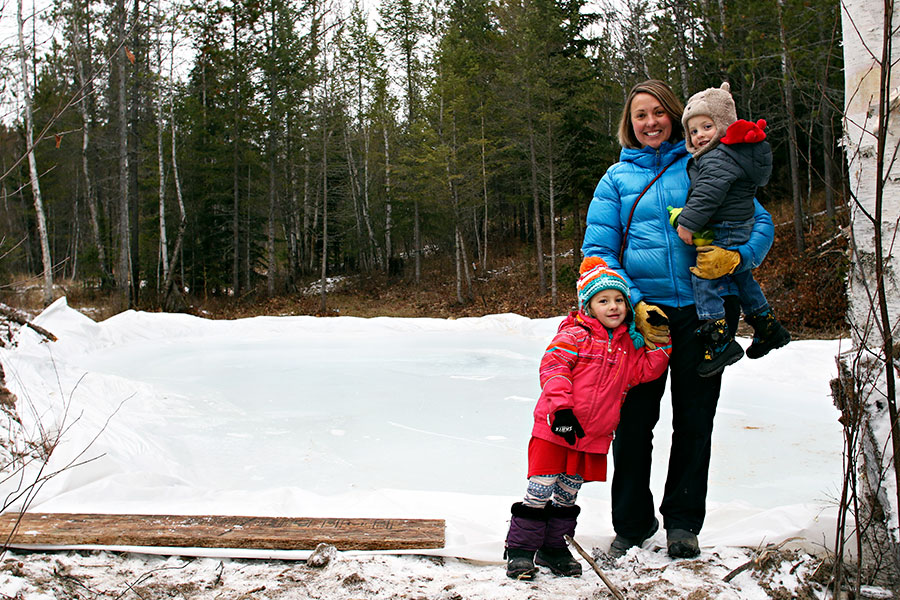When Lindsay Goudreau’s son Cove turned 3, she decided it was about time to put ice skates on the boy. Finding skates was easy, but finding a place to try them out wasn’t. So Goudreau decided to build an ice rink in the backyard.
Lindsay’s husband, a Columbia Falls native, thought it was an interesting way of solving their conundrum. But building a backyard ice rink was nothing new to Lindsay, a Minnesota native whose hometown of Delano had numerous public outdoor ice rinks, not to mention many private ones that sprouted up in front lawns and backyard across town.
“Growing up, every kid had an ice rink in their backyard,” she said. “That’s just the kind of thing you did back there.”
Two more kids and seven winters later, Lindsay has become somewhat of an expert in the art of building a backyard ice rink. Below, she describes the process.
Step 1: Finding the right spot. When Lindsay and her husband built their new house in the woods north of Columbia Falls, she knew instantly that the little gully next door was the perfect spot for an ice rink. For one, it was surrounded by trees and was just north of the house, meaning the building would shade the ice from the sun.
Step 2: Building the ice rink. After cutting a few trees, Lindsay had a nice clearing for an ice rink. Come December, she keeps a close eye on the weather, and once the temperature dips into the teens and single digits for a week or so, she gets to work. She first rolls out the most important ingredient for a backyard ice rink (besides water of course): a plastic liner. Without the liner, you’re likely to lose your water to the ground. “The liner is key if your ground isn’t frozen,” she said. This year, the liner is 35 feet by 55 feet, which gives plenty of room for a 30-by-45-foot foot ice rink.
In past years, she surrounded the tarp with lodgepole logs, but earlier this year her husband flattened out the ground with an excavator and built up a berm on the edges to better contain the water.
Next up, she rolls out the hose and starts to fill the rink. When her two youngest kids — Greta, 4 and Gus, 2 — are down for a nap or otherwise preoccupied, Lindsay will turn the hose on during the day to start the filling process, making sure to always put it away at night so the hose itself doesn’t freeze. After two or three days, she has a pool that’s anywhere from a few inches deep to a few feet deep (depending on the slope). Then she waits and lets nature take its course.
Step 3: Maintaining the ice rink. Once the ice is frozen, the fun begins but the work isn’t over. Whenever it snows, regardless of how cold it gets, Lindsay has to shovel off the ice rink in order to protect the top level. If she doesn’t, the snow will slowly start to melt the ice. Most years, Lindsay has been able to get the job done with a shovel, but last year, with an historically deep snowpack, it got to the point where she could no longer throw the snow over the banks that surrounded the rink. Toward the end of the year, she broke down and purchased an old snowblower from a neighbor.
After a number of skating lessons or pickup hockey games, the ice starts to lose its smooth surface, so Lindsay will roll out the hose again, preferably on really cold nights, and spend 20 or 30 minutes adding more water.
Step 4: Enjoy! The ice rink is usually ready to go by late December or early January. Lindsay likes to erect a flood light over the rink so the kids can skate at night and hang old Christmas lights in the trees to add a bit of atmosphere. Lindsay usually uses an old pallet to store hockey sticks, and this year her husband is planning on building a bench.
Lindsay said maintaining the hockey rink has become a labor of love, just as it was for her dad growing up. Like Lindsay does now, her dad would go out every cold night to add another layer of ice; sometimes it was so cold the hose would freeze to his gloves.
This year’s rink, which should be ready to go in a few weeks, is particularly special.
“Building the rink (this year) means more as my father passed away in April,” she said. “I’m hoping my kids enjoy the luxury of ice time whenever they want to go skate and they create fun childhood memories of their own.”
